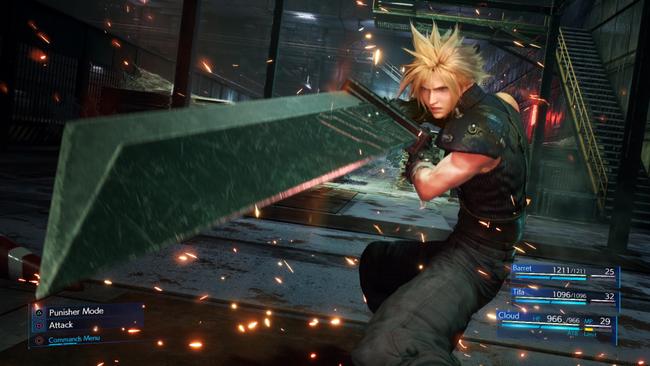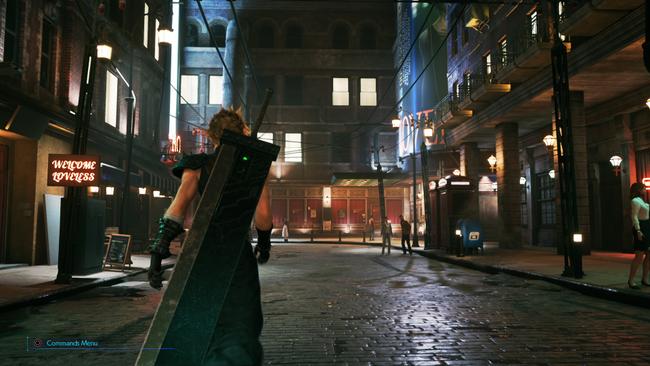The more I learn about Final Fantasy VII Remake, the less I'm worried about it
The original Final Fantasy VII is near and dear to my heart. A much younger me was just beginning to get hooked on RPGs and it enkindled my imagination about the immersive potential of games in a setting I had never experienced. When the remake was announced, my mind raced across all of the potential pitfalls ahead. Now? I think my mind’s changing.
In the first several hours of original FFVII, Midgar builds the momentum for the rest of the story: the ShinRa Electric Power Company’s greed serves as an existential threat to an otherwise oblivious or uncaring world. There are those ensnared in the promise of a comfortable life fueled by mako energy (never mind the nefarious way it’s collected) and see ShinRa’s success symbiotically with their own, blinding them to the unfolding ecological crisis and binding them to the company’s spiral towards doom.
During the first few moments of the remake’s latest trailer, Aerith clutches a wilted flower while others mill about. The Planet is dying, but what’s that got to do with me? Her gaze lifts to plead with an intangible audience for a second of concern before the scene retracts up and over a roiling megalopolis. It swallows up the flower girl until she is indiscernible from the cityscape, her form lost in a sea of mako-powered luminescence.

It’s a haunting image, especially with the original story in hindsight. It’s also an encouraging sign that the same themes will be emboldened with a protracted episode set only in Midgar. All ills in FFVII - from the Jenova Project and Sephiroth’s emergence, to a disposable underclass in Midgar’s slums, to war in distant Wutai - lead back to ShinRa at the epicenter.
Only the resistance group Avalanche stands against them, and to that end they’ve resorted to taking down the powerful mako reactors that suck the life force from the Planet. Unfortunately, the collateral damage in doing so seems to be more than the ragtag group is ready for. Already we’ve seen the seeds of doubt amongst its core members that didn’t happen until much later in the original script. Sephiroth goading Cloud by poking at his carefully-constructed identity comes earlier too, which makes sense if we’re being set up for a multi-year adventure to squeeze the “big bad” in more prominently.
We now know that the first part of this project will take place entirely in Midgar, just a slice of the world and story of the original game. Despite that Producer Yoshinori Kitase says that this narrative segment will be massaged, stretched and expanded to match the length of previous stand-alone entries in the series. This admittedly sparked concern in me. Will the scenes that so carefully frame the backbone of the VII plot also be swallowed up in a huge city with a vast breadth of gameplay and narrative distractions?
I think what convinced me in the footage Square Enix presented at this year’s E3 is that the remake looks like it isn’t being developed in the bubble of the original game's popularity and cult status. The banter between Cloud and Barret, the glimpses of expanded characterization in Biggs, Wedge, and Jessie, and so on. I became less concerned about the big story beats and how this opportunity for an expanded story could further and more deeply depict Avalanche’s struggle and ShinRa’s oppression at the center of everything. Maybe it’s still too early to call, but I like what I’m seeing.
That goes for the design of the game as well. Combat is much changed from the original, and interestingly, it looks to bring together a multitude of good ideas from later FF titles as well. In it, I see flashes of XII where Tactical Mode offers to quickly and manually issue commands as well as swap characters. There’s XIII with “staggered enemies” once certain types of attacks are used, allowing for more of an exciting tempo and payoff in battle. Even XIV feels present with thrilling transitions between phases of boss battles. Director Tetsuya Nomura has also towed along shortcut commands and interaction commands from Kingdom Hearts, which, amusingly, is an action-RPG modeled after a turn-based series.
One criticism of the original game is that each character was potentially a blank slate aside from their weapons and Limit Break abilities. Through the use of materia and the requisite slots, any party member could fulfill any purpose - negating any real need to swap around. In the remake, areas and enemies have an intention in their design, particularly for the different ways Cloud, Barret, Tifa, and Aerith move and attack. In conjunction with the materia system providing further customizability, it sets up an appealing angle to combat that didn’t previously exist.
Indeed, it feels like many things in the remake feel; fittingly grander.

Veteran fans have had different ideas of what VII looks like on grander scale - it’s piqued the collective curiosity of many for years and playfully crossed their daydreams. At one point, I couldn’t see the remake feeling right without its largely top-down angle due to how the original background art was developed - especially for locations like Midgar’s slums. Could you retain a dense, urban-enough environment that a freeform camera could convey well without a top-down view? Would it feel like the Midgar I knew?
Watching the new footage, it dawned on me that I was getting lost in a lot of small questions. Somewhere scrubbing through the different scenes I realized that, while exploring the slums, we’d be able to tilt the camera up and see the plate that divides the city in two - a sight that’s actually rather rare in the original game. Below, a city crushed with people that could only go where ShinRa’s rails go. Above, a city prostrated out before the company headquarters aglow in lamplight that mako has afforded them for their fealty. Both bound to a bleak future.
Suddenly, my granular concerns began to melt away to linger on that imagery.
Scrubbing further, Avalanche battled the Air Buster while the ShinRa building flashed in the distance - something I noted that wasn’t present in the original game. I marveled. Now, just like its role in the VII saga, it was in its rightful place: at the center of everything, looming menacingly and intently.
Undeniably, there will be a lot of concern about how a classic is remade, especially since this is a “Remake” in the most literal definition. Wrinkles of the original may be burned into our collective memory, but now it may be worth taking a step back from guarding that memory to imagine and wonder again - just as its original developers seem to be.